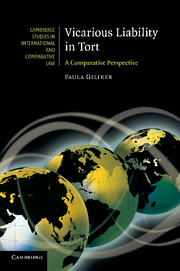Book contents
- Frontmatter
- Contents
- Diagrams
- Table of cases
- Table of legislation
- Preface
- 1 What is vicarious liability?
- 2 Establishing a general framework for liability
- 3 The employer/employee relationship: identifying the contract of employment
- 4 Special difficulties: borrowed employees and temporary workers
- 5 Other relationships giving rise to liability
- 6 Acting in the course of one's employment/functions/assigned tasks: determining the scope of vicarious liability
- 7 Parental liability for the torts of their children: a new form of vicarious liability?
- 8 Understanding vicarious liability: reconciling policy and principle
- 9 A postscript: a harmonised European law of vicarious liability?
- Appendix: Key provisions of the French and German Civil Codes
- Index
- Titles in the series
6 - Acting in the course of one's employment/functions/assigned tasks: determining the scope of vicarious liability
Published online by Cambridge University Press: 10 November 2010
- Frontmatter
- Contents
- Diagrams
- Table of cases
- Table of legislation
- Preface
- 1 What is vicarious liability?
- 2 Establishing a general framework for liability
- 3 The employer/employee relationship: identifying the contract of employment
- 4 Special difficulties: borrowed employees and temporary workers
- 5 Other relationships giving rise to liability
- 6 Acting in the course of one's employment/functions/assigned tasks: determining the scope of vicarious liability
- 7 Parental liability for the torts of their children: a new form of vicarious liability?
- 8 Understanding vicarious liability: reconciling policy and principle
- 9 A postscript: a harmonised European law of vicarious liability?
- Appendix: Key provisions of the French and German Civil Codes
- Index
- Titles in the series
Summary
Introduction
This chapter will examine the scope of vicarious liability, that is, assuming that the requisite relationship exists between the person who harms the victim (for the sake of clarity, we will call him the ‘employee’), and the defendant (the ‘employer’), the extent to which the employer will be adjudged civilly responsible for the employee's wrongful actions and thereby required to compensate the person injured. In all systems surveyed, the employer will not be held strictly liable for all torts committed by the employee. Liability will be limited by the requirement that a connection must exist between the tortious act or omission and the parties' relationship. In the common law, this takes the form of a rule that the tort in question must take place in the course (or scope) of employment. Article 1384(5) of the French Civil Code provides that ‘Masters and employers [are liable] for the damage caused by their servants and employees in the functions for which they have been employed’. German law, despite adhering to fault-based liability in § 831 BGB, similarly confines liability to harm caused ‘in the accomplishment of the tasks set’. These tests are intended to ensure that a proportionate burden is placed on defendants held liable for the wrongful acts of others.
In examining the development and operation of these tests, a number of observations may be made.
- Type
- Chapter
- Information
- Vicarious Liability in TortA Comparative Perspective, pp. 145 - 195Publisher: Cambridge University PressPrint publication year: 2010



